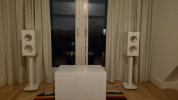mdsimon2
Major Contributor
I was able to do this with REW and a MiniDSP. Basically align the timing of the subs and mains to flatten that response
Unless you are making nearfield measurements you really do not know if you are anechoically aligned as the room will have a large contribution to the measurement. Unfortunately nearfield measurements can only be done individually on the sub or speaker so some modeling is required to understand combined response (I use VituixCAD). You want more than just time alignment, you want speaker / sub phase alignment throughout the x-over to ensure the x-over sums correctly. This usually involves a mix of pure delay to account for acoustic offset between speaker / sub at the listening position and high passing your speaker with a HPF identical to your sub roll-off (in addition to whatever HPF you may add to your speaker for the speaker / sub crossover).
If it works for you, great, there is more than one way to get good results. I like understand the anechoic response as it eliminates a lot variables before involving the room.
Michael
